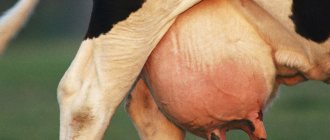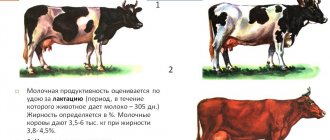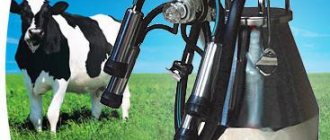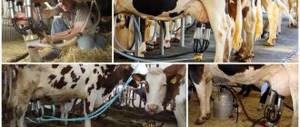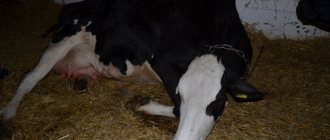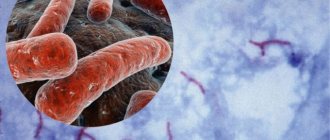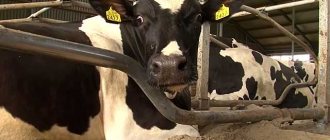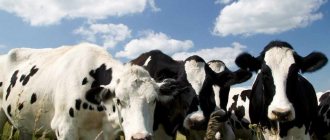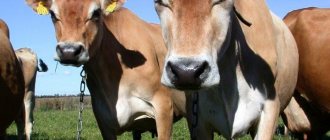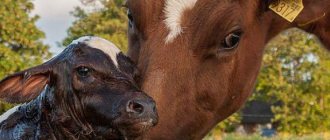Manipulations before milking
To overcome mastitis for a long time, you need not only to destroy the disease itself and fight its symptoms, but also to do everything possible to prevent the disease.
First of all, before starting milking, it is necessary to milk the first streams of milk into a special tank. This will help the housewife or operator visually evaluate the milk to see if there are any casein clots, flakes, blood, etc. in the milk.
The expressed first streams should be processed in a special reagent, which, in a fairly short time, will show the number of somatic cells. Based on the test results, it becomes clear whether the cow is healthy or not.
It is very important, before starting to treat the animal’s nipples, to massage the udder. Regular udder massage prevents the formation of clots, pathogenic tumors and milk stagnation.
- To begin massaging a cow's udder, it is necessary to clasp the right lobes of the udder with your hands: your thumbs are directed in opposite directions. The palms form a bowl.
- Afterwards, you should stroke/lightly rub the udder.
- Using circular movements with light pressure on the mammary gland, massage the udder.
- The next step is to lightly pat and push the udder from bottom to top.
- Finally, you need to massage the cow's nipples by squeezing and unclenching them. No pumping milk!
Treating the udder of cattle and small cattle BEFORE milking
Udder hygiene in cattle and small cattle means high-quality milk, a high level of milk yield, maintaining productivity, the absence of infectious and inflammatory diseases, and mastitis.
Successful management of cattle and small cattle means minimizing the risk of infectious inflammation in the animal’s body.
With poor udder hygiene: - Infectious disease pathogens enter the cow's mammary gland through the teat. — The occurrence of mastitis in cattle is up to 80%. — Dirt from a cow's teats can get into the milk. — Additional expenses on veterinary drugs are inevitable.
Methods for treating the udder and teats of a cow before milking: Dry (using dry wipes, rags); Wet (cleaning with wet wipes, rags), Wet (use special gels, foams). Wet products before milking come in the form of ready-made solutions or in the form of concentrates. The main task of teat treatment products before milking is disinfection. Experts recommend using professional udder hygiene products before milking, as they most effectively remove dirt from the cow's teats and disinfect the teat itself.
Klin Master Concentrate - Gel-soap for treating the udder before milking
ADVANTAGES - the combination of natural components ensures fast and effective removal of dirt from the udder - due to the content of a large number of softening additives, it does not irritate the skin of the udder - has a neutral pH COMPOSITION. Natural soap, glycerin, kelp extract, mustard extract. APPLICATION: Immediately before milking, dilute Clean Master Concentrate in warm water in the ratio of 100 ml of product per 10 liters of water (1% solution). For udder hygiene, wipe the nipples with a napkin soaked in the resulting solution. Upon completion of the procedure, wipe the udder teats dry.
Klin Master Active - Universal oxygen-detergent with a moisturizing effect for treating the udder before milking
BENEFITS: - contains softening and moisturizing additives, does not irritate sensitive skin - plant extracts repel insects - has a neutral pH
COMPOUND. Natural soaps, glycerin, oregano extract, green tea extract.
APPLICATION. Immediately before milking, pour 100-130 ml of product into the dipping container, shake to the desired consistency, place the teat in the dipping container for a few seconds. Upon completion of the procedure, wipe the udder teats dry.
Klin Master (Concentrate) (10l) Klin Master (Concentrate) (1l)
Wedge Master Active (10 l) Wedge Master Active (1 l)
Treating the udder before milking
Infectious disease pathogens enter the cow's mammary gland through the teat. In addition, dirt from the cow's teats can get into the milk and this will definitely affect the quality of the product. Before milking, you need to clean the area where the cow is milked and the cow itself.
There are three ways to treat a cow's udder and teats:
- Dry.
Cleaning using dry paper or cloth napkins or rags. - Wet.
Cleaning with damp antibacterial wipes or rags soaked in special solutions. - Wet.
Most experts consider the wet processing method to be the most effective. To clean the nipples of cows, special gels, foams and soap solutions are used.
Wet products before milking come in the form of ready-made solutions or in the form of concentrates. The main task of teat treatment products before milking is disinfection.
Experts recommend using professional udder hygiene products before milking, as they most effectively remove dirt from the cow's teats and disinfect the teat itself.
Primary udder treatment
Infectious disease pathogens can penetrate along with dirt or manure into the mammary gland through the nipple canal. This will definitely provoke the development of mastitis. In addition, dirt particles get into the milk during milking, which affects its quality. Before you start milking, the cow's teats, bowl, belly and legs must be washed and treated with antiseptic substances. For processing, 3 methods are used:
- dry; using disposable paper or fabric napkins “Sowotaan”, “Dermatex”;
- wet; using wet wipes soaked in lotions and antibacterial agents; napkins are disposable; It is recommended to use the material “Profilaclopre”, “Profilac Hexopre”, “Profilac Dermapre”;
- wet cleaning; is the most effective; gels, foam and soap solutions are used.
For wet cleaning, the following products are used: “Hygiene Lacto-Start”, “Algalit”, “Priolit”, “Fitolit”. Prepare soap solutions and clean warm water for final washing. To prevent the spread of infection, each cow is provided with an individual bowl of water and a napkin for washing and drying the udder. The detergent should be easily washed off with water. Otherwise, soap residue will end up in the milk. The most commonly chosen products are those containing lactic acid and hydrogen peroxide. The acid helps relax the muscles: the cow feels relieved. Hydrogen peroxide destroys pathological microflora.
The soap solution is applied using napkins that are soaked in a bowl, or using a spray bottle. The spray container is filled with detergent, the nipples are irrigated with it and washed off with clean water. For drying, use disposable paper napkins.
Hygiene of dairy cows involves not only cleaning the udder before and after milk collection. It is necessary to massage the breast. Its duration is 30 seconds. It is necessary to stimulate milk production. If milking is carried out using a machine method, then after processing the mammary gland, milking cups must be put on the nipples for a minute. Don’t forget to express the first drops of milk into another container.
The first drops of milk are not expressed on the ground. They are necessary for carrying out an initial visual analysis of milk quality. If it does not contain clots or blood impurities, and has not changed its consistency, then it can be sold. Otherwise, the raw materials are discarded.
More on the topic: Brief description and instructions Mastiet forte for cows
Treating the udder after milking
The teat sphincter is a natural barrier to bacteria, but after using the milking machine, the teat canal of the udder remains open for up to 2 hours. During this period, the cow's udder is especially vulnerable, as dirt can easily get inside. To prevent diseases, teats must be treated with special disinfectants after milking.
Solutions for treating the udder after milking work on the principle of a protective film. It envelops the skin of the cow's nipple, penetrating into all folds and crevices. In addition, udder hygiene products have antiseptic properties.
Udder treatment before and after milking. This is important to know!
Is it necessary to treat the udder after milking?
Not so long ago, treatment of a cow's udder after milking was limited to the use of cream or ointment with a dubious composition.
And to wipe the udder before milking, ordinary laundry soap was used. Yes, these methods had a number of disadvantages, but at that time there was nothing to replace them. But livestock farming is developing at a rapid pace, which means that methods of caring for animals must also be improved. Obtaining high-quality dairy products is possible only with a combination of correct animal care measures. Udder hygiene before and after milking plays a significant role in this. Neglect of udder hygiene inevitably leads to a decrease in the quality of the resulting milk and various animal diseases. The most common of these is mastitis. If you make simple mathematical calculations, the cost of treatment before and after milking is significantly lower than the losses from a cow with mastitis. In addition, a sick cow is a constant source of infection, which can spread to other cows. There is only one conclusion: you shouldn’t try to save money; treating cows’ udders before and after milking is not a luxury, but an effective way to prevent mastitis. Izhsintez-Khimprom offers high-quality and affordable ITALMAS products for treating teats before and after milking. Regular use of ITALMAS udder hygiene products is the key to the health of your cow and the prevention of many diseases.
What should be the udder treatment after milking?
What are the main functions of a teat treatment after milking?
- disinfection of udder skin;
- protection of the nipple canal from pathogenic microflora;
- moisturizing and nourishing the skin of the udder;
- regeneration of udder skin and healing of minor damage;
- restoration of irritated udder skin after milking
Now let's try to figure out what you should pay attention to when choosing a product for treating the udder after milking?
| Requirements for the product | Products for treating the udder after milking from Izhsintez-Khimprom |
| dripping | 4 to 7 drops |
| Formation of a film to protect the nipple canal | Thin, durable film that evenly covers the nipple |
| Caring properties | Softens and moisturizes the skin of the udder, has a regenerating effect |
In order to ensure the quality of ITALMAS VPITALMAS VP-I 2500ITALMAS VP-PGITALMAS VP-M products, you can order a trial sample. You can leave a request on the company’s website or seek advice by phone. We will answer all your questions, as well as select the means and tell you about their use.
How to properly wash a cow's udder
It is necessary to treat the cow's udder before and after milking. If the farmer adheres to the dry or wet method of processing the udder, then he should especially carefully wipe each teat of the cow with napkins. By the way, you need to use a new rag for each nipple.
Treating the udder using a dry or wet method does not provide 100% protection against harmful bacteria and microorganisms.
Adherents of the wet method should treat nipples by dipping them into a ready-made solution, which destroys all pathogenic organisms and contaminants on the animal’s nipples, thereby preventing them from getting into the milk.
Regularly change and clean the cloths, wipes, attachments and bottles you use for udder hygiene.
Why is cow udder hygiene essential?
Delicious fresh cow's milk, without any foreign odor or unwanted inclusions, almost 100% guarantees the success of your home business.
If the milk is of high quality, then you will always have buyers and additional profit. Sometimes it is very significant - on average, one cow brings 24 thousand rubles. income per month.
Mandatory treatment of the udder before and after milking helps:
- Prevent mechanical contaminants (manure, soil, hay, urine) from getting into the milk.
- Penetration of dirt and infection into the nipple canal.
- Perform an unobtrusive massage of the udder, which will serve as a signal to the cow to “let in” milk.
This is interesting(!) In most cases, inflammatory diseases of the udder occur after dirt gets into the nipple canal - this can cause the development of mastitis. Clean and dry hands and udders, absence of cracks and other damage to the skin are the key to healthy mammary glands.
Next, we will consider all the stages of preparing the udder for manual or machine milking, so that the cow is healthy and the milk is tasty and of high quality.
Before milking, it is necessary to assess the cow’s condition, behavior, and mood.
Udder cleanliness assessment
Cleanliness of the udder and teats is a fundamental factor for obtaining quality milk. There are 4 categories of cow udder contamination.
| Category | Category Description |
| First category | A cow is classified in the first category if not only the udder, but the entire cow is completely clean |
| Second category | The udder is slightly dirty - about 2-10% |
| Third category | Average degree of surface contamination. Contaminated about 10-30% |
| Fourth category | More than 30% polluted. Severe contamination of the udder and the cow as a whole |
Cows with contamination grades 3 and 4 are at greater risk of mastitis.
What to do with mastitis milk
Healthy milk, through the milking machine through the milk line, goes into the cooling tank. Milk from a cow that has mastitis must be milked in a separate container using a separate machine.
After milking mastitis milk, the milking machine must be thoroughly washed and dried.
The presence of a large number of somatic cells leads to a decrease in the value of milk. This milk has a low percentage of fat, sugar and acidity. In addition, it does not withstand high temperatures well. Mastitis milk has an unpleasant taste and odor. With a high degree of somatic cells, flakes and pus can be found in the milk.
Milk from a cow that is infected with mastitis is dangerous for children to consume.
